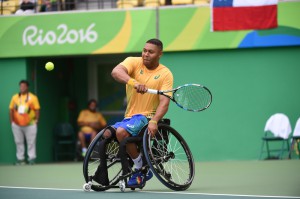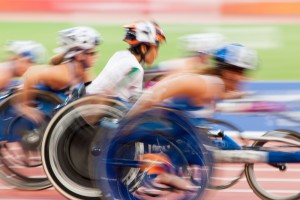Guest post by Dr. Simon Gerard and Dr. Ian Brittain, Centre for Business in Society
Like the National Health Service the Paralympic Movement celebrates its 70th anniversary this year. The first Stoke Mandeville Games, held at Stoke Mandeville hospital in Aylesbury on the 29th of July, 1948 are considered to be the founding episode that led to the birth of the Paralympic Movement.
By looking more closely at the emergence of the Stoke Mandeville Games, it is possible to shed new light on the social context around these games as well as the mechanisms and strategies that gave birth to the Paralympic Games a little over a decade later.
 Dr Ludwig Guttmann (1899 – 1980) is considered as one of, if not the founding father of the Paralympic Movement. Guttmann was a German-Jewish neurosurgeon who, fled the Nazi regime with his family and settled near to the city of Oxford in 1939. In 1943, the British Government appointed him director of the newly formed National Spinal Injury Unit at the Ministry of Pensions Hospital at Stoke Mandeville.
Dr Ludwig Guttmann (1899 – 1980) is considered as one of, if not the founding father of the Paralympic Movement. Guttmann was a German-Jewish neurosurgeon who, fled the Nazi regime with his family and settled near to the city of Oxford in 1939. In 1943, the British Government appointed him director of the newly formed National Spinal Injury Unit at the Ministry of Pensions Hospital at Stoke Mandeville.
Guttmann saw in this position the opportunity to both develop new rehabilitation methods for spinal cord injuries as well as to challenge social perceptions and defeatist attitudes towards people with a paraplegia. The life expectancy of those receiving a spinal injury during the First World War was only six weeks but had risen to only a few months prior the Second World War. People with a spinal cord injury were therefore viewed as incurable and medical staff shared little hope regarding their social or professional futures.
Guttmann was convinced of the physical, psychological and social benefits induced by active rehabilitation in the treatment of spinal cord injuries. This approach was somewhat revolutionary given that, at that time, the rehabilitation process was mainly composed of massages, passive movements and bedrest. Unsurprisingly sport was soon introduced as part of the treatment plan for all patients within the centre.
Archery
Over time numerous sports were introduced including table tennis, wheelchair netball (which later became what we now know as wheelchair basketball), track and field event, swimming, snooker and darts. These sport activities were an integral part of the rehabilitation process and were closely supervised by the medical staff. One particular sport, archery, played a particularly important role in this process. It also allows us to better capture the meaning afforded by Guttmann and his collaborators to these sporting activities.
According to Guttmann, archery had an immense therapeutic value because it developed “those muscles of the upper limbs, shoulders and trunk on which the paraplegic’s well-balanced upright position depends”. Moreover, it represents one of the rare sports in which wheelchair athletes can compete on an equal basis against non-disabled archers. Archery therefore facilitated exchanges between the patients and the outside world and was in line with the social re-inclusion aims promoted by Guttmann.
The Stoke Mandeville Games
These sport meetings led to the organisation of more formal sport competitions for people with a spinal injury. The first Stoke Mandeville Games, simply called “Sports Day”, took place on July 29th of 1948. These Games became an annual event and became international in 1952 when a team from the Doorn Military rehabilitation Centre (Netherlands) travelled to Stoke Mandeville especially to participate in the Games. The Games rapidly grew both in terms of countries involved or sports included on the programme. For example, no less than 350 athletes from 20 countries competed across 10 sport disciplines during the 1958 Stoke Mandeville Games, having grown from just 37 competitors and two sports in 1949. However, it should be pointed out that in the early decades of the Stoke Mandeville and Paralympic Games only athletes with spinal injuries were allowed to compete.
Expansion’s mechanisms and strategies

So how, in only a few years, did the Stoke Mandeville Games become the cornerstone of the international sport movement for people with a spinal injury? It is possible to identify some distinct mechanisms and strategies that may help explain this development.
First former patients from Stoke Mandeville hospital played an important role, easing the spread of adapted sport and physical activities once transferred in a new hospital nearer their home or back to civilian life. Similarly numerous physicians travelled to Stoke Mandeville and learned from Guttmann’s methods. Next, the journal The Cord was created by 6 ex-patients from Stoke Mandeville to promote the interests of those having s spinal cord injury, especially given that practical information for paraplegics was in short supply at that time. This journal was exported internationally spreading word of Guttmann’s methods and reporting on the main sport results. Today only a handful of complete editions of The Cord are still in existence.
Dr Guttmann himself was a tireless worker and firm believer in sport as a rehabilitation tool. Because of his strong character, leadership and his determination, Guttmann deeply and lastingly shaped the early development of the Paralympic Movement. He attended numerous conferences, travelled endlessly around the world and prolifically wrote about his endeavours. He was also very skilled in obtaining support for the Games from both the political and sociocultural spheres. British elite politicians, members of the British Royal family and even movie stars were systematically invited for the Stoke Mandeville Games’ opening and closing ceremonies to present awards to the victors, which in turn attracted greater media attention for the Games..
Finally, one of the most efficient strategies to consolidate the Games was to systematically associate them to the Olympic Movement and the Olympic Games. Even if we don’t know with certainty to what extent it was planned the first Stoke Mandeville Games took place the exact same date as the Opening Ceremony of the 1948 Olympic Games and in 1949, Guttmann stated during a speech that one day, “the Stoke Mandeville Games would become the equivalent of the Olympic Games”. Guttmann pushed this idea forward by organising the 1960 international Stoke Mandeville Games in the city of Rome, where the Olympic Games took place a few weeks before. According to a close collaborator of Guttmann, Dr Tricot, this initiative sought to stamp these Games with “the Olympic Seal, so consecrating the therapeutic role of sport in paraplegics’ rehabilitation”. The 1960 Stoke Mandeville Games are today considered as the first Paralympic Games.




Comments are disabled